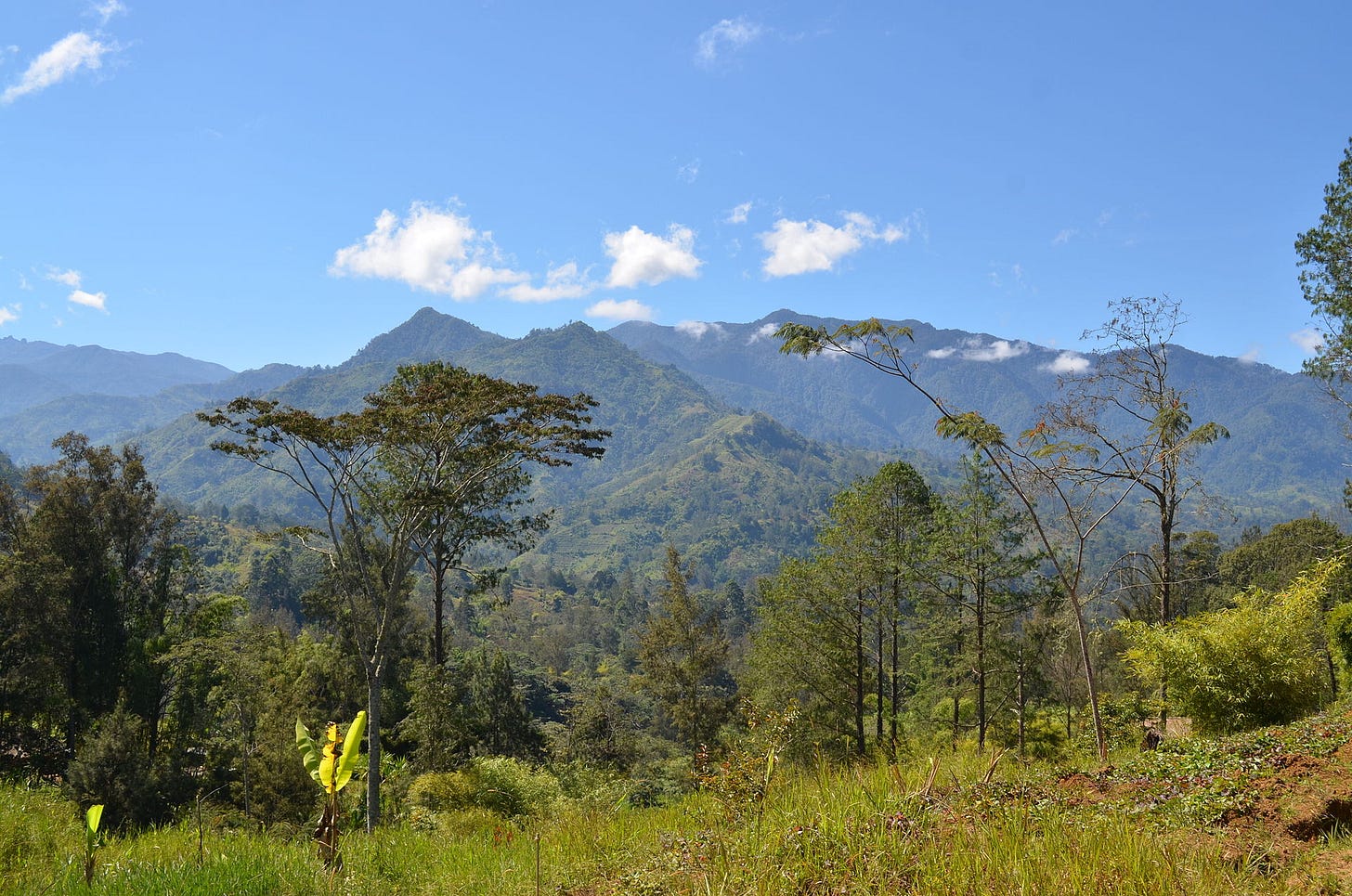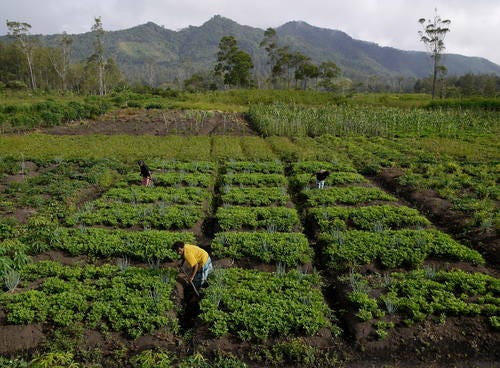The Highlands of New Guinea are one of the most remote and forbidding places on the planet. A chain of mountains a thousand miles long splits the island from end to end, a wall of nearly impassable jagged peaks and ridges rising to 16,000 feet at their highest point. Even reaching the foothills - themselves thousands of feet in elevation - before the long climb upward requires a long, difficult slog through the marshes and tropical forests of the lowlands.
For these reasons, it’s not hard to understand why it took outsiders - Europeans and Australians - until the 1930s to realize that these seemingly inhospitable mountains actually contain a profusion of pleasant, cross-cutting valleys. These valleys were absolutely teeming with people: not a few wandering foragers eking out a living on the edge of subsistence, but large villages full of sedentary agriculturalists who cultivated a variety of crops and kept domesticated animals. Thousands of groups lived there, competed, and made war with one another. They had been doing so for a very, very long time.
The Highlands don’t seem like the most welcoming place on the planet, but they actually form a unique ecological zone. Thick evergreen rainforest covers the slopes up until around 5,000 feet in elevation, which then gives way first to mixed forest and high meadows after that. Altitude determines what grows where, and what resources are available for people to exploit. For groups that were willing to travel up and down the hills and mountains, passing along those cross-cutting valleys, they could collect plenty of plants and animals to sustain them. People did this for many thousands of years; the oldest evidence of habitation in the Highlands dates to more than 20,000 years before the present.
Around 10,000 years ago, people living in the Highlands began trying something new. They, like people all over the world around this time, started to experiment with actively cultivating plant foods: not just gathering what happened to be available, but planting or transplanting the things they wanted to harvest and eat, creating gardens and artificial landscapes to suit their needs. The New Guinea Highlands, far from being a backwater stuck in the mists of the past, were actually one of the few places in the world where agriculture was invented from scratch.
Why? They had been foragers for thousands of years. What need was there to try something new?
This is a fundamental question, not just for New Guinea but in many different places in the early millennia of the Holocene Epoch, which began 11,700 years ago. At around this time, people in the Fertile Crescent were domesticating wheat, barley, cattle, goats, and sheep; millet, rice, and pigs along the Yellow and Yangzi Rivers; maize in Mesoamerica; tubers in Amazonia; and other crops and animals in still more places, including South Asia and the Andes. The overarching answer probably has something to do with the new prevailing climatic conditions, but whether it was greater variability or greater stability is hard to say.
In the New Guinea Highlands, the trigger probably had something to do with the climatic shift and the changing environments in which people found themselves. A forager living at 5,000 feet in elevation before the Holocene, at the end of the Pleistocene Epoch, would have been roughly at the altitude where the high forest met the mountain grasslands. Without having to move very much up and down the mountains, these people would have had access to a great variety of food sources. But as it got warmer and wetter in the Holocene, the rainforests climbed the hillsides, the high forest went up, and the open meadows were out of reach altogether. Faced with those circumstances, people could either choose to climb higher to continue their way of life, or they could stick around and try something new.
At a place called Kuk Swamp, located in the Upper Wahgi Valley of the eastern Highlands, they decided to try something new.
About 10,000 years ago, people came to Kuk Swamp and cleared away some mountain forest from the valley floor, probably using fire. They then dug small channels and piled up the earth onto upraised mounds, where they planted their crops and tied them to stakes or posts to keep them upright and out of the omnipresent waters of the swamp. These people stuck around for a little while, probably a couple of years, and then moved on to another site where they presumably did something similar.
This is a pattern of agriculture called shifting cultivation. It’s particularly suitable to the soils of tropical regions, which tend to be low in nutrients and quickly exhausted by cultivation. If groups practice shifting cultivation for long enough in a particular area, they effectively transform the landscape, creating a mosaic of older forests, new regrowth on recent plots, and open land currently under cultivation. That variety of landscapes has a lot to offer for a group of mobile farmers.
Their preferred crops were yams, bananas, and taro, all of which were native to the Highlands, if not that particular elevation. In fact, the Highlands were almost certainly the original home of the ubiquitous domesticated banana, which is today consumed all over the world. (Fun fact: the banana isn’t actually a tree. What we think of as the “trunk” is actually the stem of the world’s largest herb.)
For a while, it seems like this pattern of shifting cultivation was the way of life around Kuk Swamp. Around 5000 BC, though, it was no longer viable. More permanent styles of cultivation were necessary, and we can see this next phase at Kuk Swamp, too. Instead of moving from patch to patch, they settled down, digging a series of small, regular mounds, each of them a few feet across. The lower spaces in between served as drainage channels to carry away rain- and floodwaters. On the edges of the mounds, they planted their taro; taro grows below the ground and doesn’t mind water. At the center of the mounds, they planted their bananas and sugarcane, which don’t do well in sodden ground. It’s a brilliant solution to a problem, and the net effect was to create a huge artificial environment capable of sustaining a permanent population. They continued to innovate at Kuk Swamp for thousands of years afterward, eventually digging large drainage ditches to allow for even more intensive cultivation.
Kuk Swamp is unequivocal evidence for the independent invention of an ingenious agricultural system, one much different than what we see elsewhere in the world. Beyond that, there are two fascinating things about the place and its context, at least to my way of thinking.
First, the archaeological remains at Kuk Swamp aren’t grand temples, palaces, or even houses. We don’t see pottery or even many artifacts at all, just a few stone tools, and only a few of them. Instead, we see lines in the mud, tiny pieces of charcoal, and microscopic plant remains. It’s not an especially impressive-looking assemblage, and it requires all of the cutting-edge tools archaeologists have developed over the past half-century to turn it into a compelling story about the distant past.
Second, and more important, the invention of agriculture in the Highlands never led to craft specialization, cities, complex social and political hierarchies, or state formation. Villages and populations grew, “Big Men” emerged as leaders, and conflict and violence between groups was endemic. Yet we don’t see anything resembling a linear path from the invention of agriculture to what so many naively consider “civilization.” It never happened in New Guinea.
That’s not because these people somehow fell off the correct developmental path; it’s because there’s no such thing as the correct path. Linear ideas about the natural evolution of societies over time are simply wrong. Developments don’t have to occur in a particular sequence. They don’t have to occur at all, and the people and places who don’t participate in them are no lesser for that fact. Sophistication and ingenuity come in many different forms.
If the origins of agriculture in New Guinea are interesting to you and you’d like to learn more, check out today’s episode of Tides of History. Next week, I won’t have a newsletter, but I’ll be interviewing one of the world’s leading experts on Kuk Swamp and agriculture in the Highlands, Tim Denham. He’s a super cool guy with a lot of fascinating insights.
I wrote a book! It's called The Verge: Reformation, Renaissance, and Forty Years that Shook the World. The book comes out in July, but you can pre-order it here.







could you help me information and black and white pictures on Tigi plantation in Dei district, in 1960s to 1980s
Listening to these Papua New Guinea episodes reminds me of a lot of other archeological sites such as in Time Team, were Archiolofist are always trying to make sense of what they find. I find curious that everything they find that is of uncertain use, is always for rituals, worship or weapon. How about a musical instrument? I believe music is a natural part of human development. We have found songs and hymns dating back to thousands of years. There are four basic type of producing music. Membranophones, Chordophones, Idiophones and Aerophones. If you stretch a piece of leather, pluck a rope or string, bang a rock or hard surface, or blow through it and it makes different sounds, you got an instrument. Have any archeologist considered this? I can imagine several people making tools, one bang on two rocks, another blow through a pipe, someone tensed a string while another scrapped a piece of leather. All of a sudden, they had a musical chord. They keep on doing it and the first band was born.